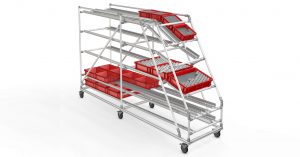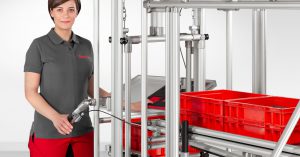These five lean principles provide a perfect illustration of what lies at the heart of lean production.
Whether in production, management or administration, continuous improvement on the basis of the lean philosophy and its many principles has been well established for many years now. Its worldwide success began with lean production, which was then adapted to suit other areas of business. Among these methods, lean management is undoubtedly the best known. In this context, people also talk about the overarching concept of lean thinking. U.S. economists James P. Womack, Daniel Roos and Daniel T. Jones started this boom with their study “The Machine That Changed the World: The Story of Lean Production” (1990), in which they used the term “lean production” to describe the Toyota Production System. Most notably, the authors acquainted the Western world with the methods that have brought Toyota spectacular success.
Essentially, the aims of lean production are continuous improvement and a reduction in throughput times. Throughput times and productivity are closely linked, so cutting throughput times boosts productivity. It is primarily a case of reducing waste, imbalance and overloading. But how, specifically, can the goals of lean production be achieved? Five principles referred to by Womack and Jones are useful here – added value for customers, value streams, flow, the pull principle and Kaizen and/or the continuous improvement process.
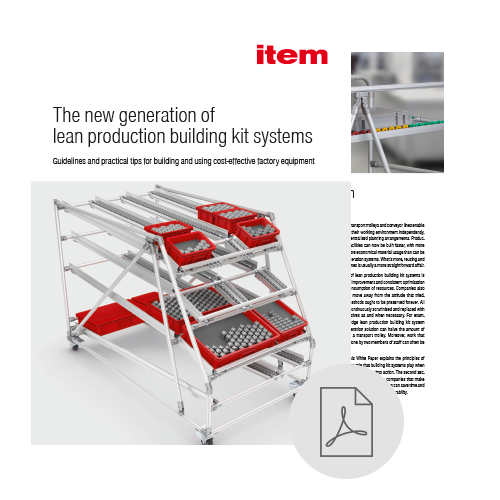
The world of lean production
Less waste and more added value – lean production methods help you make targeted improvements to your production efficiency. Our white paper provides a concise introduction.
DOWNLOAD NOW
Identifying and defining the value of a product from the customer’s perspective
In lean production, a customer-centric approach is of key importance. It is therefore vital to identify and document the value of a product from the customer’s perspective. This value is all about quality, price and – above all – delivery reliability. Since the entire process chain is relevant here, internal customers within the company also come into the picture, but the focus should be on end customers. It is only when this value has been defined that it becomes clear which activities actually add value. It is then possible to assess from the customer’s perspective whether the right product is delivered in the right quality at the right time and in the right form. By doing this, it is also possible to identify activities which are essential or useful for the customer – as well as those that are superfluous from a customer perspective.
Value stream, part 1 – mapping and diagram
The key lean principles also include mapping the value stream and subsequently improving it. A value stream encompasses all the business processes a company needs in order to manufacture and supply a product. Thanks to value-stream mapping (VSM), it is possible to generate a precise picture of the current state of these processes so that the value stream becomes clearly visible. Value-stream mapping involves observing individual process steps, measuring the time they take and visualising them in a flow chart. Generally speaking, VSM is always carried out for a group of products that undergo similar process steps. Before the mapping can take place, appropriate product groups therefore need to be defined, and this is done by documenting the products and the related production steps in a special matrix:
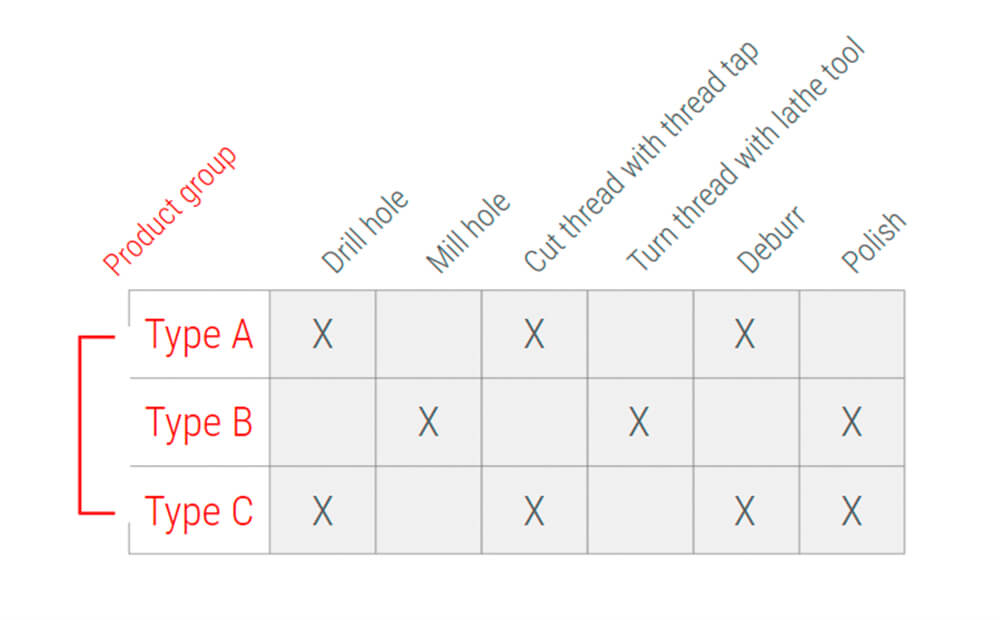
Once the product groups have been formed, the next step is to visualise the current situation in the form of a value-stream diagram. Basic, material flow and information flow symbols are used in this diagram. A value-stream diagram has a fixed structure, in which the customer in the top right-hand corner is the starting point. The mapping process is then carried out upstream, i.e. through production and back to the supplier. The complete value-stream diagram can be used to work out where in the value stream improvements can best be made. These might relate to aspects such as throughput time or stock levels, for instance.
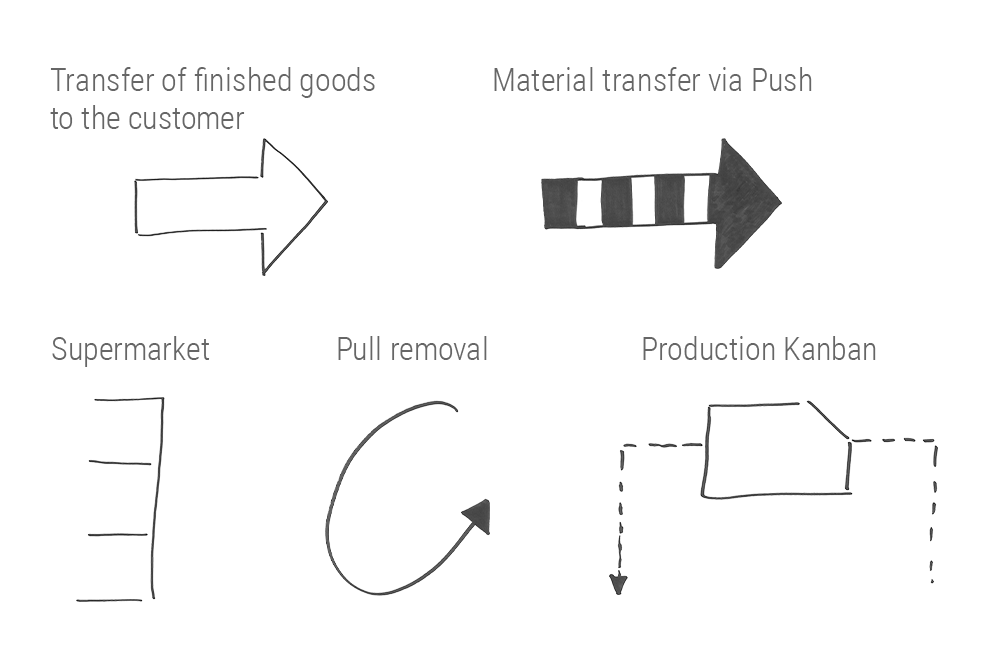
Value stream, part 2 – creating the value-stream design
Value-stream mapping is followed by value-stream design. The aim of this is to set a new target standard for the processes being considered. The first step involves defining the improved target state of the process chains. In other words, it is initially a case of working together to develop a vision of the ideal state. The tool used for this process is a value-stream diagram, which provides a clear picture of the target standard. When improving the current state, the aim is to reduce throughput times, which generates the following benefits:
- Shorter delivery times for customers
- Lower stock levels, which ties up less capital
- More flexibility
- Improved ability to react
Once the value-stream mapping and value-stream design stages have been completed, the groundwork has been laid. Now, employees work towards achieving the desired standard within a period of three to six months, by means of the continuous improvement process (CIP). Activities that don’t add value are therefore gradually dispensed with. In the world of lean production, these activities are known as Muda. There are seven Muda – types of waste – in total. Muda is one of the 3Ms – the other two are Mura (“imbalance”) and Muri (“overloading”). The Muda concept is more concrete, which means it is easy to lose sight of the Mura concept, even though this is the actual source of waste.
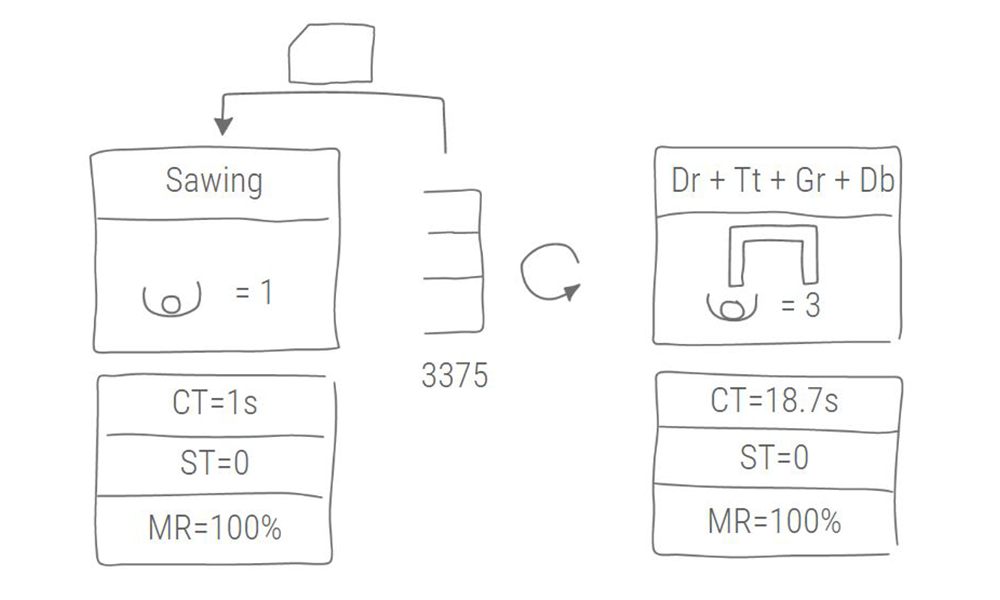
Thinking lean – combining everything into a single flow
Once waste has been eliminated from the value stream, it’s time to apply the flow principle. In the context of lean production, “flow” means that production takes place continuously, without any interruptions. It is therefore important to avoid anything that would disrupt this flow, such as buffer stock and interim storage. High levels of warehouse stock and avoidable waiting times thus also come under the umbrella of the seven Muda or types of waste. To avoid these, processes should be synchronised with the help of the customer takt time. When improving production on the basis of the flow principle, it is not only a case of examining individual work steps. Instead, all steps and departments need to be considered. However, it is often difficult to combine everything into a single flow, especially for companies that are not engaged in series production. It is therefore important to note that this lean principle cannot be implemented in every case.
One of the lean principles – efficient material flow thanks to the pull principle
In contrast to the traditional push principle, which is based on sales forecasts, the pull principle works on the basis of the customer’s actual demand. A quick look at the disadvantages of the push principle immediately highlights the benefits of the pull principle. Since the push principle is based on a forecast, production has already taken place at the company by the time a customer’s order is received. Although this approach means that optimum use is always made of the workforce’s capacity, the disadvantages of the push principle outweigh this benefit. For one thing, big warehouses are needed to store the large quantities of stock. From a lean production perspective, this represents waste, since it ties up both financial resources and space. What’s more, this approach also often results in overproduction – another type of waste. Another disadvantage is that the material flow is interrupted as a result of products constantly being placed into and removed from storage, including interim storage. Consequently, throughput times cannot be reduced by applying the push principle – and the primary aim of lean production is therefore not achieved.
Compared to the push principle, a key advantage of the pull principle is that, by designing production around short setup times, several product variants can be manufactured on the same production line.
The pull principle works in exactly the opposite way. In this case, production is steered by demand. Quite literally in fact, since a product is only manufactured when a customer orders it. Compared to the push principle, a key advantage of the pull principle is that, by designing production around short setup times, several product variants can be manufactured on the same production line. Short delivery times can therefore be ensured – and extensive warehouses for components and finished products are no longer needed. Here are the key advantages of the pull principle at a glance:
- Small batch sizes
- No overproduction
- Continuous material flow, with no interruptions to place products into storage
- Shorter delivery times (on average)
- Far less storage space required
Kaizen and the continuous improvement process (CIP)
Anyone who takes an interest in lean principles will inevitably come across the concept of Kaizen. What’s more, there can be no doubt that Kaizen plays a key role in lean production. However, there is an important distinction to be made here. In many cases, people are unaware of the differences between Kaizen and the continuous improvement process (CIP), but these principles are not identical. Kaizen is a traditional mindset in Japanese culture – a belief that everything in life can always be improved bit by bit. It is connected with a positive attitude that involves facing up to challenges and proactively looking for solutions. It’s all about perpetually striving for perfection. The very name says it all, since “Kai” means “change”, while “Zen” means “for the better”. In contrast, the continuous improvement process (CIP) relates exclusively to processes in the workplace. Originally, this method applied only to work steps within industrial production. However, the success of lean production has led to overarching concepts such as lean management and lean thinking.
Factory equipment such as transport trolleys, material supply racks on castors and flow racks with roller conveyors is created in CIP workshops. A solution such as the Lean Production Building Kit System from item is ideal for this.
Nowadays, for instance, using CIP for office organisation is also common practice. However, our focus here is on traditional CIP in production, which is at the heart of lean production. When it comes to continuous improvement, all production areas are ultimately considered. Continuous improvement is made in as many small steps as possible. A crucial aspect here is that the correct CIP mindset can only be established if it goes hand in hand with a positive attitude towards mistakes – in other words, errors should explicitly be regarded as an opportunity for improvement. Although perfection is something to strive for, it can never actually be achieved. Consequently, transparency, trust and leeway for staff are all vital features of a functional CIP culture. Special CIP workshops create the spatial and organisational basis needed for this. In these workshops, appropriate components are used to build factory equipment such as transport trolleys, material supply racks on castors and flow racks with roller conveyors. A solution such as the Lean Production Building Kit System from item is ideal for this. The Building Kit System centres on Profile Tube System D30, which boasts mechanically locked connections for a strong and lasting hold and extremely simple fastening technology.
Lean, lean, lean – the principles of continuous improvement
Over the years, an extensive archive of knowledge about the principles of lean production has been built up on the item blog. This topic has proved highly popular with our readers right from the outset. We have been very happy to respond to this interest – and, of course, we continue to do so. Here you will find a selection of our blog posts about making targeted improvements to production.
- Kaizen – the principle behind it, what it means and how it differs from CIP
- Value-stream mapping – definition and examples
- Designing value streams – steps and symbols
- Visual management – 5S and Poka-Yoke
- Jidoka – definition, origins and benefits
- Examples of CIP – boosting productivity in manufacturing
- Process optimisation in production – an expert opinion
- What is lean management?
Are you interested in fascinating reports and innovations from the world of lean production? Then we have just what you’re looking for! Simply subscribe to the item blog by completing the box at the top right.


